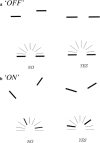Hemispheric preference in visuospatial processing: a complementary approach with fMRI and lesion studies
- PMID: 10864232
- PMCID: PMC6871993
- DOI: 10.1002/(sici)1097-0193(200006)10:2<80::aid-hbm40>3.0.co;2-2
Hemispheric preference in visuospatial processing: a complementary approach with fMRI and lesion studies
Abstract
Historically, the left cerebral hemisphere has been considered specialized for language, whereas the right cerebral hemisphere is aligned with spatial processes. However, studies have called into question adherence to this model and suggested that both hemispheres participate in language and spatial cognition. Using functional Magnetic Resonance Imaging (fMRI) and human brain lesion studies, we determined whether these complementary techniques could clarify issues of hemispheric dominance. Using a modified Benton Judgement of Line Orientation (JLO) test, considered a relatively pure spatial processing task, we found robust and significant (p < 0.0005) bilateral superior parietal lobe activation on fMRI in ten right-handed male adult volunteers. This was corroborated by lesion data in a cohort of 17 patients who showed significant JLO impairments after either right or left parietal lobe damage, with right parietal damage associated with somewhat more severe deficit. Detailed wavelet analysis of the fMRI time-series did, however, reveal a more dominant role of the right parietal lobe in "kick-starting" the task. To our knowledge, this is a novel way of using fMRI to address functional hemispheric differences in a cognitive task that is known to have bilateral representation.
Figures




Similar articles
-
Influences of Long-Term Memory-Guided Attention and Stimulus-Guided Attention on Visuospatial Representations within Human Intraparietal Sulcus.J Neurosci. 2015 Aug 12;35(32):11358-63. doi: 10.1523/JNEUROSCI.1055-15.2015. J Neurosci. 2015. PMID: 26269642 Free PMC article.
-
The neural basis of vertical and horizontal line bisection judgments: an fMRI study of normal volunteers.Neuroimage. 2001 Jul;14(1 Pt 2):S59-67. doi: 10.1006/nimg.2001.0819. Neuroimage. 2001. PMID: 11373134
-
Acute visual neglect and extinction: distinct functional state of the visuospatial attention system.Brain. 2011 Nov;134(Pt 11):3310-25. doi: 10.1093/brain/awr220. Epub 2011 Sep 23. Brain. 2011. PMID: 21948940
-
Right-hemispheric dominance for visual remapping in humans.Philos Trans R Soc Lond B Biol Sci. 2011 Feb 27;366(1564):572-85. doi: 10.1098/rstb.2010.0258. Philos Trans R Soc Lond B Biol Sci. 2011. PMID: 21242144 Free PMC article. Review.
-
[The hemispheric functional specialization of visual perception].Usp Fiziol Nauk. 1997 Jul-Sep;28(3):54-77. Usp Fiziol Nauk. 1997. PMID: 9381778 Review. Russian.
Cited by
-
Identification of a novel link between adiposity and visuospatial perception.Obesity (Silver Spring). 2023 Feb;31(2):423-433. doi: 10.1002/oby.23603. Epub 2022 Dec 22. Obesity (Silver Spring). 2023. PMID: 36546337 Free PMC article.
-
Functional neuroanatomy of spatial orientation processing in Turner syndrome.Cereb Cortex. 2004 Feb;14(2):174-80. doi: 10.1093/cercor/bhg116. Cereb Cortex. 2004. PMID: 14704214 Free PMC article.
-
Visuospatial and mathematical dysfunction in major depressive disorder and/or panic disorder: A study of parietal functioning.Cogn Emot. 2016;30(3):417-29. doi: 10.1080/02699931.2015.1009003. Epub 2015 Feb 24. Cogn Emot. 2016. PMID: 25707308 Free PMC article.
-
The oblique effect: The relationship between profiles of visuospatial preference, cognition, and brain connectomics in older adults.Neuropsychologia. 2019 Dec;135:107236. doi: 10.1016/j.neuropsychologia.2019.107236. Epub 2019 Oct 22. Neuropsychologia. 2019. PMID: 31654648 Free PMC article.
-
Functional hemispheric asymmetries during the planning and manual control of virtual avatar movements.PLoS One. 2017 Sep 28;12(9):e0185152. doi: 10.1371/journal.pone.0185152. eCollection 2017. PLoS One. 2017. PMID: 28957344 Free PMC article.
References
-
- Benton AL. 1969. Disorders of spatial orientation In: Vinken PJ, Bruyn GW, editors. Handbook of clinical neurology (Vol. 3). Amsterdam: North Holland; p. 212–228.
-
- Benton A, Tranel D. 1993. Visuoperceptual, visuospatial, and visuoconstructive disorders In Heilman KM, Valenstein E, editors. Clinical neuropsychology (3rd Ed.). New York: Oxford University Press; p. 165–214.
-
- Benton AL, Van Allen MW. 1968. Impairment in facial recognition in patients with cerebral disease. Cortex 4: 344–358. - PubMed
-
- Benton AL, et al. 1978. Visuospatial judgment: a clinical test. Arch Neurol 35: 364–367. - PubMed
-
- Benton AL, et al. 1994. Contributions to neuropsychological assessment. New York: Oxford University Press.
Publication types
MeSH terms
Grants and funding
LinkOut - more resources
Full Text Sources

